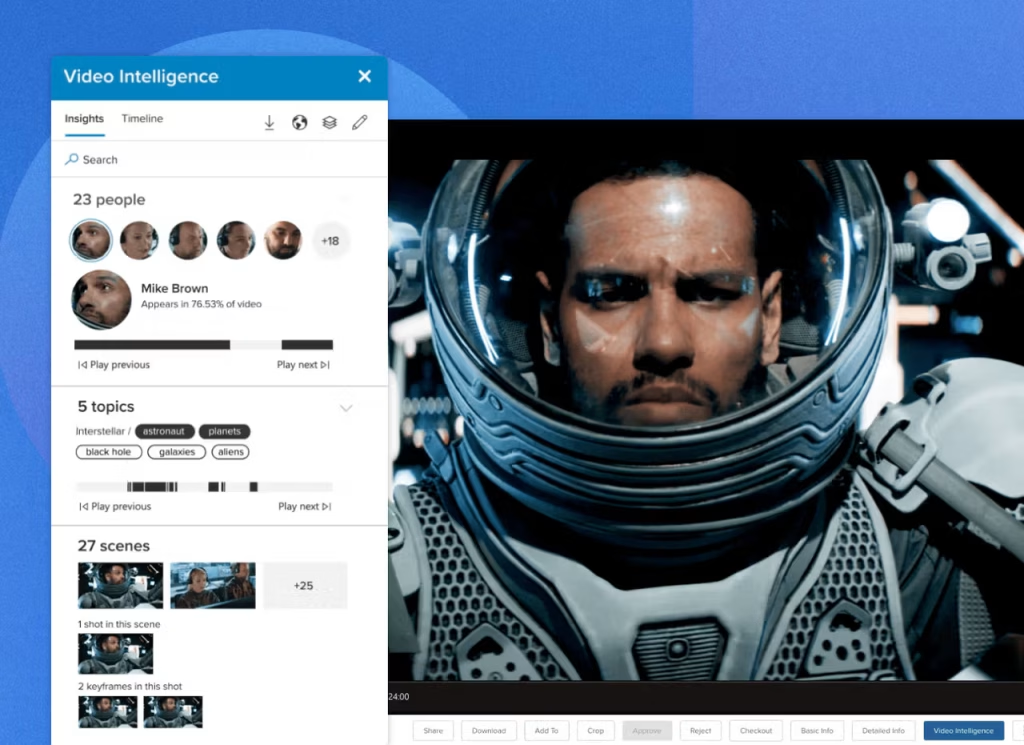Video is now the most consumed content format across industries—from marketing campaigns and sales enablement to training, education, and customer support. In fact, 81% of organizations will integrate video into their content strategies in 2025.
But as video use skyrockets, so does the challenge of managing it. According to the Video Asset Management Report, 61% of organizations struggle with the management of video libraries. The question is: should companies rely on traditional video hosting platforms (like Vimeo or YouTube) for storage and playback, or invest in a Digital Asset Management (DAM) system that manages video alongside every other digital asset?
This article compares both approaches and explains why more organizations are turning to DAM to future-proof their video strategy.
What Is Traditional Video Hosting (or VAM)?
Traditional video hosting platforms (sometimes called Video Asset Management tools, or VAMs) focus on optimizing playback, distribution, and performance analytics for video content. Features often include:
- Video compression and streaming
- Embedding and sharing tools
- Video-specific metadata (timestamps, transcripts, closed captions)
- Playback analytics
These platforms are useful for publishing and sharing video but rarely address broader content workflows.
What Is Digital Asset Management (DAM)?
DAM systems manage all digital assets, including images, documents, creative files, and video. A DAM ensures assets are:
- Centralized in a single source of truth
- Tagged with metadata for easy search
- Protected with permissions and audit trails
- Integrated with creative, CMS, and project management tools
- Ready for distribution across channels
With DAM, video sits alongside every other brand asset—making it easier for marketing, creative, and compliance teams to work from the same hub.
Understanding the Tools: Strengths & Limitations
Video Hosting (VAM) Benefits
- Optimized for video playback and streaming
- Video-specific metadata like transcripts and chapters
- Cost-effective for organizations with video-only needs
Drawbacks:
- Limited to video assets only
- Minimal collaboration or approval workflows
- Lack of integration with non-video content libraries
DAM Benefits
- Centralizes all content types: video, images, documents, design files
- Improves discoverability: 67% of DAM users say AI-powered search and metadata tagging significantly improve video asset discoverability
- Supports scalability: Built for enterprise-level storage and compliance requirements
- Enhances distribution: 50% of DAM users note omnichannel video publishing improved distribution and repurposing across platforms
- Drives efficiency: Integrated workflows, permissions, and integrations with tools like Adobe Creative Cloud, Microsoft Teams, and CMS platforms

Drawbacks:
- Less specialized for advanced video-only metadata (e.g., transcript search by speaker)
When to Choose Which?
- Choose Traditional Video Hosting if:
You need lightweight storage and streaming for a library of videos with minimal workflows.
- Choose DAM if:
You manage video and other content types, need centralized governance, want compliance-ready audit trails, and require collaborative workflows like proofing.
Notably, 100% of organizations using DAM for video management report being satisfied with their tool, highlighting the value of investing in a scalable, enterprise-ready platform.
Interested in learning more about video asset management? Read the full report here:

How Fred Rogers Productions Transformed Video Asset Management with DAM
Fred Rogers Productions, the nonprofit behind Mister Rogers’ Neighborhood and modern PBS hits like Daniel Tiger’s Neighborhood, manages a treasure trove of over 1,150 television episodes across more than 70 years. Add thousands of images, audio clips, documents, and expanding new media—this archive represents both legacy and opportunity. Yet, their past system was failing them.
The Challenge: A Legacy Locked In
- Their previous, on-premise solution was slow, unreliable, and inaccessible off-site.
- Metadata was inconsistent or missing, making search almost futile—simple queries (like finding a purple sweater shot) could take hours or go unresolved.
- System discontinuation eroded trust; users even questioned whether assets were accessible at all.
“It was beyond frustrating… people didn’t trust it. It was made for admins, not end users.” Jack Rowley, Digital Asset Manager at Fred Rogers Productions
The Solution: MediaValet Video-Focused DAM
The organization chose MediaValet, a cloud-based DAM built with video at its core. The goals? Fast, secure access from anywhere, simplified search, and tools scalable for both legacy preservation and future production.
Key Features That Drove the Transformation:
- Audio/Video Intelligence (AVI): Automatically transcribes dialogue, identifies objects, faces, and scenes. Search the phrase “purple sweater in front of the castle”—and instantly find the exact moment.
- Voice Transcription & Captions: Generates searchable transcripts, even for clips with no prior subtitles—boosting accessibility and precision for tasks like social media clip sourcing.
- Video Trimming Inside DAM: Teams can instantly clip segments without third-party tools—streamlining creation of social-ready content and creative outputs.
Results: From Hours to Seconds, Frustration to Engagement
- 85%+ staff adoption—a cultural shift from hoarding to exploration.
- Search time dropped from hours to seconds.
- Cross-departmental empowerment—marketing, licensing, legal, production, and fundraising now rely on DAM as a central tool.
“It’s not just a place where we keep things—it’s where we distribute them… that’s the real charm of a DAM.” Jack Rowley, Digital Asset Manager, Fred Rogers Productions
Why This Matters
Fred Rogers Productions shows how a properly structured, AI-powered DAM turns a sprawling media archive into a living, accessible resource:
- Transforms heritage into utility. Teams rediscover and reuse rich legacy content as active assets.
- Deploys innovation to fuel storytelling. Quick discovery enables dynamic marketing and creative campaigns rooted in legacy.
- Fosters efficiency and equity. All staff, from marketing to legal, can access the same trusted library, without gatekeeping.
Interested in reading their full story? Check out the Fred Rogers case study here.
DAM Wins for Long-Term Value
Traditional video hosting platforms serve a purpose—but they’re limited. In contrast, a DAM offers scalability, governance, and collaboration across all content types, not just video.
Traditional video hosting platforms are useful for storage and streaming, but they’re limited to a single content type. For organizations that rely on video as a core part of their strategy, a Digital Asset Management system offers far more value.
With DAM, teams not only centralize and secure their video libraries—they also make them discoverable, reusable, and ready for omnichannel publishing. That’s why more organizations are making the switch: 53% of DAM users say integrated workflows accelerate approvals and reduce bottlenecks, and satisfaction rates among DAM video users stand at 100%.
Ready to transform how you manage video? Learn how MediaValet supports video asset management.




